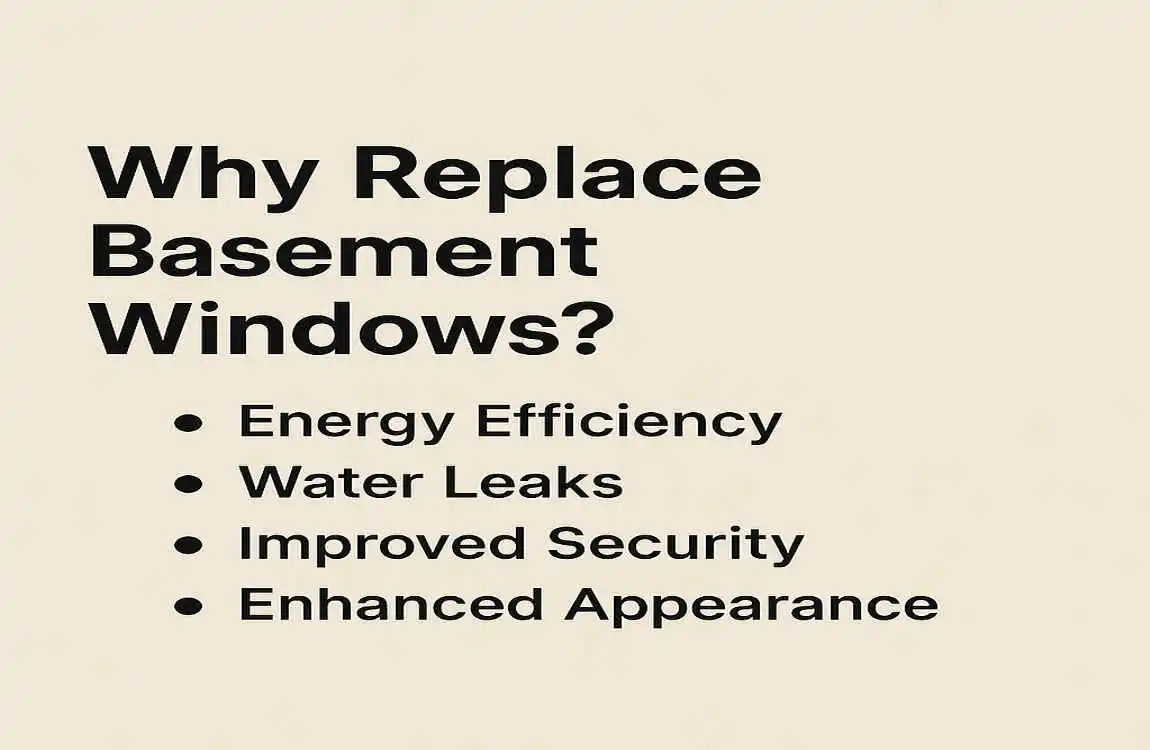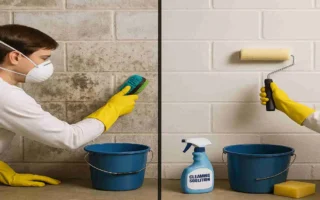Installing replacement vinyl basement windows is an easy and impactful home upgrade that enhances your basement’s energy efficiency, security, and aesthetic appeal. This straightforward DIY project involves removing the old window, properly fitting the new vinyl window in the existing opening, leveling it with shims, securing it in place, and sealing it with insulation and caulking to prevent leaks. Vinyl windows are durable, low-maintenance, and improve your home’s comfort while lowering heating and cooling costs. It’s a cost-effective way to brighten and modernize your basement space while maintaining safety compliance and preventing water damage.
Why Replace Basement Windows?

Signs Your Basement Windows Need Replacement
If you’re unsure whether your basement windows need replacing, keep an eye out for these common signs:
- Drafts: Feeling a chilly breeze coming through your windows? It’s a sure sign they’re not sealing correctly.
- Leaks: Water stains or puddles around your windows indicate they’re not keeping the elements out.
- Rot: Wooden frames that are soft or crumbling need to be replaced to prevent further damage.
- Difficulty Opening: If your windows stick or are hard to open, they may be warped or damaged.
Benefits of New Vinyl Basement Windows
Upgrading to new vinyl basement windows offers several advantages:
- Energy Efficiency: Vinyl windows offer excellent insulation, helping you save on heating and cooling costs.
- Improved security: Modern vinyl windows often feature built-in security features, such as reinforced frames and secure locking mechanisms.
- Easier Maintenance: Vinyl windows are low-maintenance and resistant to rot, warping, and fading.
Impact on Home Value and Curb Appeal
Replacing your basement windows can enhance your home’s value and curb appeal. Potential buyers will appreciate the energy-efficient upgrade and the fresh look it brings to your basement.
Cost-Effectiveness of DIY Installation
By installing your replacement vinyl basement windows yourself, you can save on labor costs and recoup your investment more quickly. With the right tools and a little elbow grease, you can complete this project on a budget.
Understanding Replacement Vinyl Basement Windows
What Are Replacement Vinyl Basement Windows?
Replacement vinyl basement windows are designed to fit into your existing window openings, making them an easy and cost-effective way to upgrade your basement. They’re made from durable vinyl material and come in various styles and configurations.
Main Types and Configurations
When choosing replacement vinyl basement windows, you’ll have several options:
- Hopper Windows: These windows open inward from the top, allowing for easy cleaning and ventilation.
- Slider Windows: Slider windows move horizontally, making them ideal for narrow spaces.
- Fixed Windows: Fixed windows don’t open but provide a clear view and plenty of natural light.
Advantages of Vinyl Over Wood or Aluminum
Vinyl is an excellent choice for basement windows due to its many advantages over wood or aluminum:
- Durability: Vinyl is resistant to rot, warping, and corrosion, making it ideal for the damp basement environment.
- Insulation: Vinyl has excellent insulating properties, helping to keep your basement comfortable year-round.
- Low Maintenance: Unlike wood, vinyl doesn’t require painting or staining, and it’s easy to clean with just soap and water.
Common Features
When shopping for replacement vinyl basement windows, look for these standard features:
- Double-Pane Glass: Double-pane glass provides better insulation and noise reduction compared to single-pane glass.
- Tilt-In Sashes: Tilt-in sashes make cleaning your windows a breeze, as you can easily access the exterior from inside your home.
- Screens: Many vinyl basement windows come with built-in screens to keep bugs out while letting fresh air in.
Key Considerations When Choosing New Windows
Before purchasing your replacement vinyl basement windows, consider these factors:
- Size and Fit: Ensure the new windows will fit properly in your existing openings.
- Energy Efficiency: Look for windows with a high energy efficiency rating to maximize your savings.
- Style and Appearance: Choose windows that complement your home’s aesthetic and meet your functional needs.
Essential Tools and Materials Checklist
To successfully install your replacement vinyl basement windows, you’ll need the following tools and materials:
Tools
- Measuring tape
- Pry bar
- Level
- Caulk gun
- Drill
- Shims
- Utility knife
- Screwdrivers
- Safety gear (gloves, safety glasses)
Materials
- Replacement vinyl basement window(s)
- Caulking
- Spray foam insulation
- Flashing tape
- Exterior trim
- Fasteners
Where to Buy Affordable, Quality Supplies
You can find affordable, quality supplies at your local home improvement store or online. Look for reputable brands and read reviews to ensure you’re getting the best value for your money.
How to Measure for Replacement Vinyl Basement Windows
Accurate measurements are crucial for a successful installation. Follow these step-by-step instructions to measure your basement windows correctly:
Step-by-Step Measuring Instructions
- Height: Measure the height of the window opening from the top to the bottom, both on the left and right sides. Take the smaller of the two measurements.
- Width: Measure the width of the window opening from left to right, both at the top and bottom. Take the smaller of the two measurements.
- Depth: Measure the depth of the window opening from the interior to the exterior. Ensure the new window will fit within this space.
Tips for Accurate Measurements
- Use a sturdy, reliable measuring tape for accurate results.
- Measure multiple times to double-check your numbers.
- If your basement has uneven walls or sills, take measurements at several points and use the smallest number.
Mistakes to Avoid When Measuring
- Don’t assume all your basement windows are the same size; measure each one individually.
- Avoid measuring the existing window frame instead of the opening itself.
- Don’t forget to account for the window’s frame when measuring the opening.
Worksheet/Table for Recording Your Window Measurements
Window Location Height (inches)Width (inches)Depth (inches)
Window 1
Window 2
Window 3
Preparing the Basement Window Opening
Before installing your new replacement vinyl basement windows, you’ll need to prepare the window opening. Follow these steps:
Removing Old Window Sashes and Frame
- Put on your safety gear, including gloves and safety glasses.
- Use a pry bar to carefully remove the old window sashes and frame from the opening.
- Dispose of the old window materials responsibly, following local guidelines.
Inspecting for Damage
Once the old window is removed, inspect the opening for any signs of damage:
- Rot: Check the wood around the opening for soft or crumbling areas.
- Mold: Look for any mold growth, which may indicate moisture issues.
- Moisture: Check for water stains or signs of leaks.
- Structural Damage: Ensure the opening is structurally sound and free from cracks or weak spots.
Cleaning, Leveling, and Prepping
Clean the window opening thoroughly, removing any debris or old caulking. Use a level to ensure the opening is plumb and level. If necessary, shim the opening to create a flat surface for the new window.
Repairing or Patching
Suppose you find any damage during your inspection, repair or patch the affected areas before proceeding with the installation. Use appropriate materials, such as wood filler or epoxy, to ensure a solid base for your new window.
Ensuring a Weather-Tight Frame Area
Before installing the new window, ensure the frame area is weather-tight. Apply flashing tape around the opening to create a barrier against moisture. This step is crucial for preventing leaks and maintaining the integrity of your basement.
Step-by-Step Guide: How to install Replacement Vinyl Basement Windows
Now that you’ve prepared the window opening, it’s time to install your new replacement vinyl basement windows. Follow these steps for a successful installation:
Unpack and Inspect the New Window
Carefully unpack your new window and inspect it for any damage or defects. If you notice any issues, contact the manufacturer or supplier immediately.
Dry-Fit the Window
Before permanently installing the window, perform a dry fit to ensure it fits properly in the opening. Place the window in the opening and check that it’s level and plumb. Make any necessary adjustments to the opening or shimming.
Insert Window Using Proper Shimming Techniques
Once you’ve confirmed the fit, it’s time to install the window permanently. Use shims to ensure the window is level and plumb within the opening. Place shims at the bottom, sides, and top of the window, as needed.
Secure the Window
Follow the manufacturer’s instructions to secure the window in place. Typically, this involves screwing the window frame to the surrounding structure. Be sure to use the appropriate fasteners and follow the recommended screw placement.
Apply Flashing Tape and Waterproofing
To prevent leaks and ensure a weather-tight seal, apply flashing tape around the exterior of the window. Follow the manufacturer’s instructions for proper application and overlap.
Seal the Window
Use a high-quality caulking to seal the interior and exterior of the window. Apply a bead of caulk around the perimeter of the window, both inside and out. Smooth the caulk with a damp finger or tool for a clean, professional look.
Insulate Gaps with Spray Foam
To further improve energy efficiency, fill any gaps between the window frame and the surrounding structure with spray foam insulation. Be careful not to overfill, as this can cause the window to deform.
Finishing Touches and Trim Work

With the window securely installed, it’s time to add the finishing touches and trim work:
Installing Interior and Exterior Trim
Install the interior and exterior trim around the window to give it a finished look and provide additional weather protection. Follow the manufacturer’s instructions for proper installation.
Painting or Sealing
If your trim requires painting or sealing, do so according to the manufacturer’s recommendations. Choose a high-quality paint or sealant that’s suitable for the trim material and the basement environment.
Reinstalling or Adding security Devices and Screens
If your old window had security devices or screens, reinstall them on the new window. If not, consider adding these features for added safety and comfort.
Cleaning the Workspace and New Window
Once the installation is complete, clean up your workspace and the new window. Remove any debris, excess caulk, or spray foam. Clean the window glass with a mild detergent and water, then dry it with a lint-free cloth.
Troubleshooting Common Installation Issues
Despite your best efforts, you may encounter some common installation issues. Here’s how to troubleshoot them:
Window Doesn’t Open or Close Smoothly
If your window is sticking or difficult to operate, check for any obstructions or misaligned tracks. Lubricate the tracks and hinges with a silicone-based lubricant to improve operation.
Gaps or Leaks After Installation
If you notice gaps or leaks around your new window, check the caulking and flashing tape. Reapply or adjust as needed to create a tight seal. If the issue persists, you may need to remove the window and re-shim it for a better fit.
Dealing with Minor Mis-Sizing
If your new window is slightly too large or small for the opening, you can use shims or trim to adjust the fit. However, if the mis-sizing is significant, you may need to return the window and order a different size.
Water Infiltration: Causes and Simple Fixes
If water is leaking into your basement around the new window, check the flashing tape and exterior caulking. Ensure these are correctly applied and intact. If necessary, reapply or replace them to create a watertight seal.
When to Call a Professional
If you encounter any issues that you’re not comfortable addressing yourself, or if the installation seems beyond your skill level, don’t hesitate to call a professional. It’s better to seek help than to risk damaging your new windows or your home.
Maintenance Tips for Vinyl Basement Windows
To keep your new replacement vinyl basement windows looking and performing their best, follow these maintenance tips:
Routine Cleaning
Clean your windows regularly to remove dirt, dust, and grime. Use a mild detergent and water, and avoid abrasive cleaners that can scratch the vinyl. Clean the tracks and sills to prevent debris buildup.
Lubrication for Smooth Operation
To keep your windows operating smoothly, lubricate the tracks and hinges periodically with a silicone-based lubricant. This will help prevent sticking and ensure easy operation.
Inspecting Seals, Caulking, and Insulation
Inspect the seals, caulking, and insulation around your windows annually. Look for any signs of wear, cracks, or gaps. Reapply or replace these materials as needed to maintain energy efficiency and prevent leaks.
Preventing Moisture and Mold Problems
To prevent moisture and mold issues in your basement, ensure proper ventilation and address any water leaks or drainage problems promptly. Keep the area around your windows clean and dry to discourage mold growth.
Safety and Legal Considerations
Working Safely
When installing basement windows, prioritize your safety. Wear appropriate protective gear, including gloves and safety glasses. Be cautious when removing old windows, as they may have sharp edges or broken glass. Dispose of old windows responsibly, following local guidelines.
Fire Egress Codes
If your basement is used as a living space, you may need to comply with fire egress codes. These codes ensure that occupants can safely exit the basement in case of an emergency. Check with your local building department to determine if your new windows meet these requirements.
Consulting Local Building Codes or a Contractor
Before beginning your basement window installation, familiarize yourself with local building codes and regulations. If you’re unsure about any aspect of the process or if your project requires a permit, consider consulting a professional contractor. They can help ensure your installation meets all necessary standards.




